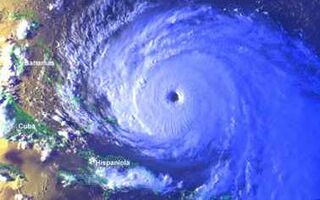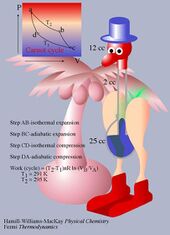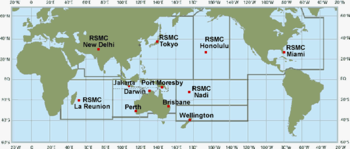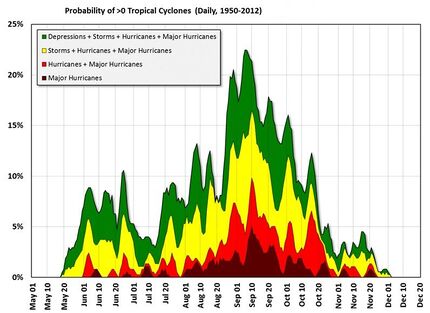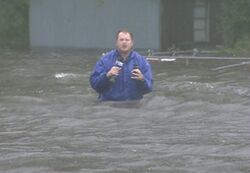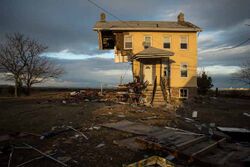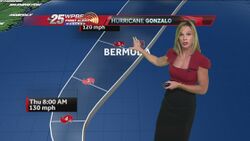Hurricane
A hurricane is an intense depression that develops in tropical latitudes and is the cause of very high winds, rain, and heavy seas.
The Earth's climate is bipolar, oversensitive, and tends to mood swings, often bringing grey skies, rain, and blustery wind; particularly in the mid-latitudes where countries such as the UK moan about it constantly. A hurricane is a much deeper psychological depression that tends to destruction and violence; for example, when Hurricane Ike famously battered the town of Tina in Missouri.
Hurricanes either appear over the sea or from their home in Hurricane Alley. Sea-based hurricanes tend to track west until reaching landfall, whereas land-based hurricanes tend to follow TV stormchasers. Wind speeds within a hurricane are anything from 70 knots to over 135 knots. They vary in size as much as intensity and have a diameter between 60 and 2,500 miles. On land, they cause storm surges, regional flooding, and excessive silly news coverage.
Physical structure
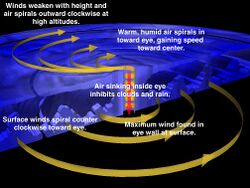
Wind field
Within a hurricane, the wind is rotational. The depressed air pressure at the center of the storm, in the first instance, causes the air mass to move towards the eye; however, the rotation of the earth causes the air mass to have a circular movement, known as coriolis force. This is the same force that causes human waste to rotate in a certain direction when being flushed.
Eye and center
The center of a hurricane is generally calm, with beautiful clear skies and warm temperatures. The diameter, on average, is 20 to 40 miles, but can be much greater. Like other bi-polar depressions, this often fools people into thinking that the tantrum is over. The passing of the eye however, is a short rest-bite before an even more violent reaction within hours. The outer edge of the eye is known as the eyewall. It resembles an arena or football stadium, and thus is where the greatest violence occurs.
Physics
Energy
The amount of energy a hurricane releases is the equivalent to 200 times the electricity generated throughout the world, or to releasing a 10 megaton nuclear bomb every 20 minutes. These statistics should have been a heads-up that playing with nature, such as building the Hadron Collider with the intention to make black holes, is perhaps a bad idea.
Carnot engine
In order to power such destruction, a hurricane requires heat energy and a process to convert that heat energy to kinetic energy. The hurricane’s answer came in the form of a Carnot heat engine, devised by Frenchman Nicolas Léonard Sadi Carnot in 1824. The engine acts by transferring energy from a warm region of, say the sea, to a cool region, such as space. The air movement allows some of that energy to do a little mechanical work, such as tear Belize to pieces turn New Orleans into The Venice of Death. The Carnot engine was eventually replaced in France by the less reliable, less powerful Citroen engine, as cars really don't require all that horsepower.
Warning centers
There are six regional warning centers, relating to the six areas, or basins, that hurricanes form. The warning centers are designated by the World Meteorological Organization.
There are many other ways to get information on the arrival of a hurricane, such as Mitt Romney telling all U.S. citizens to proceed at haste to their private alpine ski lodges or second homes. Unusual local events can also indicate the arrival of a hurricane, like water pouring into the living room, windows blowing in or a neighbor’s entire upstairs appearing in the back yard.
Local emergency services are also trained to suspect the arrival of a hurricane. The fire service will go on hurricane alert on receiving multiple requests to assist with trees stuck up cats. Another warning sign is observing whether cows are starting any pre-flight checks (see Travel).
Classification
There are several categories of hurricane force, depending on the area. The Saffir-Simpson Hurricane scale is based on the amount of clothes would be torn from an individual as the storm passes.
It is probably the most accurate of all classifications, as demonstrated by Wall Street Journal’s roving reporter, Gina Chon being left completely exposed and in a state of high distress after a pass made by category five hurricane McGurk. Chon was left wearing nothing but an A4 folder marked “Obama Administration Security Council”.
Formation and action
Drift and multiple storm interaction
Hurricanes tend to drift towards eastern coasts, and then curve north. This irritates Northerners, as they have a tendency to get a kick out of any reports of suffering by those living in the normally benign and sunny south. Storms do merge as fisherman George Cluny fatefully discovered in 2000. Although a talented actor, he was not the sharpest swordboat skipper. Being the proverbial man’s man, Cluny never looked at weather forecasts, and just made the statement “I always get the fish” before heading to the Flemish Cap. In the case of his last trip, the fish got him.
Seasons
Hurricane season runs parallel to the cricket season, contrasting the soothing sound of leather striking willow; to the not so soothing sound of building striking building. Peaking in the hazy summer months, September is the most active period worldwide, bringing the most exiting boundary shots on the 20/20 international circuit and on the village cricket circuit, the best locally sourced strawberries and cream.
Control
Pacifying hurricanes have been a challenge for meteorologists and scientists for decades. Many different schemes have been tired out and failed. These include seeding the hurricane with Prozac, putting Pharrell Williams on an iceberg, and rolling him into the eye for an unplugged rendition of "Happy"; and the old faithful, hitting with a nuke, which for those in the path agree that vaporization is quicker than drowning.
Commercial
Hurricanes cause large waves, high winds, driving rain, flooding, and storm surges. On land they can destroy cars, sheds, al-fresco dinner parties, and associated expensive hairstyles.
Much as those living in areas prone to forest fires claim that setting fire to their forests is actually very good for them; the hurricane's destruction of towns and cities is extremely beneficial to society, as it spurs redevelopment increasing property values. Once the weak and idle are dead and buried, the new infrastructure is built on top. Construction firms are careful not to bury any Indians together, or build a house on top of Indian graves as insurance against any poltergeist activity in the future, which can negatively affect property value. The thousand-square-mile destructive wind force also churns up rivers and estuaries a little bit, thus increasing breeding of shrimp stocks by 10% as famously discovered by Captain Forrest Gump, who likens life in the hurricane zone to a flying crate of chocolates; you never know if one is going to land on your head and kill you.
Media
The media are probably the greatest fans of the hurricane, as it provides the opportunity to stand in an area of ongoing destruction. This saves the reporter having to pay locals to roll in the dirt, then huddle together crying; or throw a grenade to get the right effect of smoke and panic just before going live on their news broadcast. The only media that don’t enjoy reporting in the hurricanes, are those from San Andreas or California. As earthquake guys, they prefer being swallowed up in sink holes or squashed by falling masonry, to being thrown thirty feet in the air by a passing piece of corrugated steel.
Travel
The fastest way to travel during a hurricane is either by balloon, kite or on the back of a cow. Flying cows in rotational wind events are always a feature of stormchasers, and it is unknown why, of all the large farm animals, it’s the cows that take the opportunity to get airborne.
Preparations
Land
Preparations on land are relatively straightforward, either run for the hills or hide under the kitchen table and wait for the roof to fall in and/or the sea to roll up the drive, bringing with it a small cabin cruiser, a couple of yachts, and a half-eaten George Cluny.
Air
Preparations for the airline industry are also relatively simple. Pilots that operate in regions prone to tropical storms are taught to formation fly with trailers, kiosks, roofing material and, of course, cows. Although the aircraft will be completely destroyed, it, and all the passengers will remain airborne in their seats, but with a bit of a hit-and-miss trolley service.
Sea
One hundred foot waves and one hundred mile an hour winds are what the Merchant Marine are all about. Able-bodied seamen dream of having to be lashed to the wheel and crusty bearded skippers yearn for the opportunity to shout orders above the howl of wind through the standing rigging. Once approaching port, the deep fetch of the sea hitting a continental shelf causes an ever increasing pitching, bringing the prop and rudder clear of the water until the vessel founders, grounds on rocks, breaks its back, and sinks.
Naming
People often wonder why hurricanes are not given names like “run for your life” or “hammer of Beelzebub.” However, meteorology is a dull subject in the main, and those who study it are even more so. In recent decades, daytime TV has introduced what senior forecasters call “totty” to present the weather, in a bid to engage a more dynamic staff base. Unfortunately, office flings between incompatible staff always end in tears and sometimes in on-air thunder. This has resulted in most hurricanes being named after ex’s or divorcees.
Notable hurricanes
Hurricaine Higgins was a world champion snooker player, manic depressive, and alcoholic. It was Higgins that inspired wind related names for snooker players, such as Windy Reardon (Ray), Light and Variable Hendry (Steven), and Good Blow Catalano (Maria).
Rubin "Hurricane" Carter, keeping with the tradition of the destructive nature of hurricanes, was a boxer who had a parallel career defending himself from murder accusations. Carter was so good at defending himself (both in court, in the ring and on the streets) that he received an horary Doctorate of Law, and was asked politely to go away, leave everyone alone and not do it again.
The "hurricane", ironically, is also sweet alcoholic drink made with rum, fruit juice, and syrup or grenadine served in New Orleans. George W. Bush famously visited New Orleans during the aftermath of Hurricane Katrina to try the drink, go fishing on the high street and hook floating voters.
In popular culture
Hurricanes have appeared in films, television, music, towns squares, car parks, bedrooms, the sea, the sky, farms, rail stations, and airports.
In music
Bob Dylan wrote a protest song about boxer Hurricane Carter, titled not "Carter" nor "The Boxer" but "Hurricane". It accused the judiciary of false imprisonment, faking evidence, and racism. The song was controversial and drew a lawsuit, as it described the boxer as the number one contender, when actually he was only ranked ninth at the time of his arrest for murder.
George Rippey Stewart's Storm Maria, where the protagonist is named Storm Maria, prompted Alan Jay Lerner and Frederick Loewe to write the song "Storm Maria" for their 1951 musical Storm Maria.
In art
Picasso believed that "art is the sum of all destructions." This attitude was fortunate because his famous "She-Goat", which resides in the gardens of New York's Museum of Modern Art, was evidently getting a bit tatty. Museum staff left it out for the next hurricane to give it a hose-down. Unfortunately, the storm was hurricane Sandy, the world's first sand-driven superstorm, which shot-blasted the goat (see picture), causing this particular piece of Picasso work to end up looking a bit "abstract". Today, the staff tell visitors it was always like that.
In literature
The only book written directly about the hurricane is the specialist hardback, Hawker Hurricane Owners Workshop Manual, by Haynes. According to the book, the UK managed to tame hurricanes and had a squadron of them in the Midlands and East Anglia. The hurricane became one of Britain's principal fighter and ground-attack weather phenomena of the war period, fulfilling a wide range of contrasting roles.
In science
Joseph Alois Schumpeter (1883–1950), in his work on "creative destruction", essentially described the entire capitalist economy as a hurricane. The great success the other side has had espousing alternatives owes to their description of those systems instead as "a sunny day with a light wind out of the west."
| Featured version: 13 July 2015 | |
| This article has been featured on the main page. — You can vote for or nominate your favourite articles at Uncyclopedia:VFH. | |
